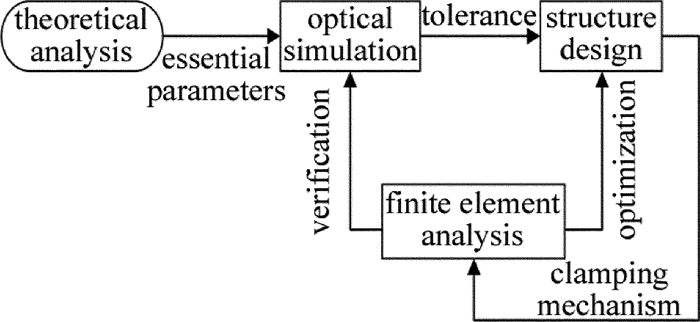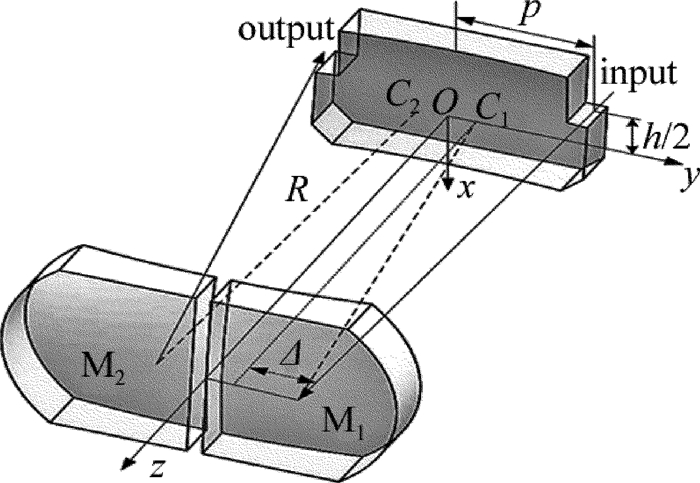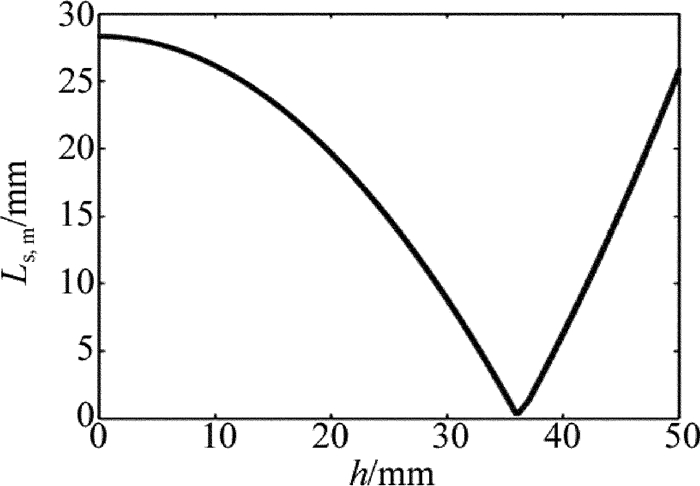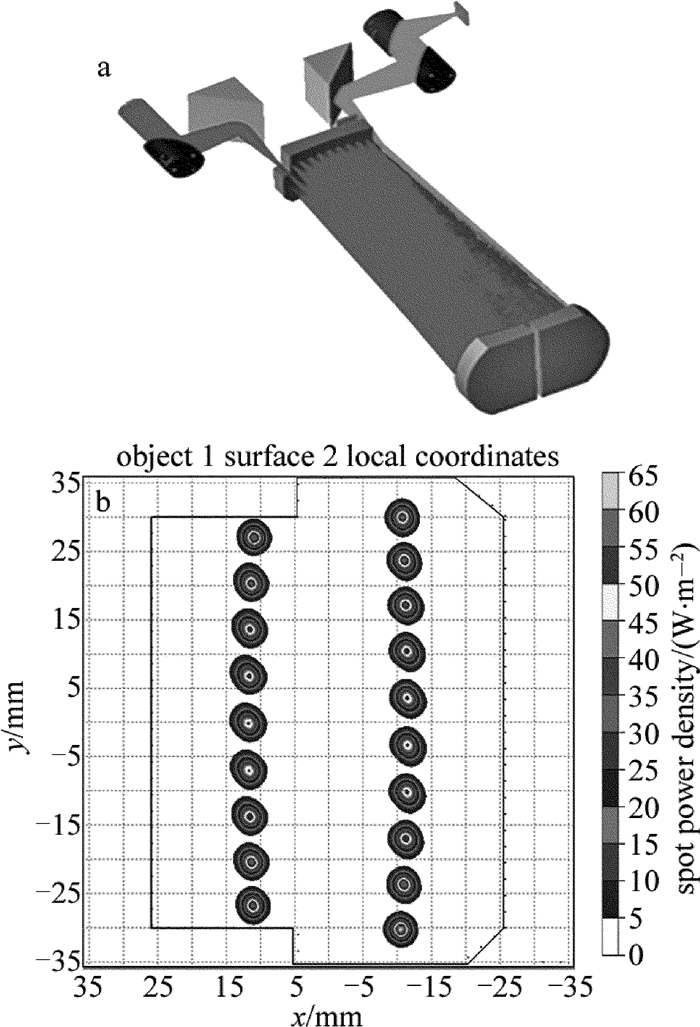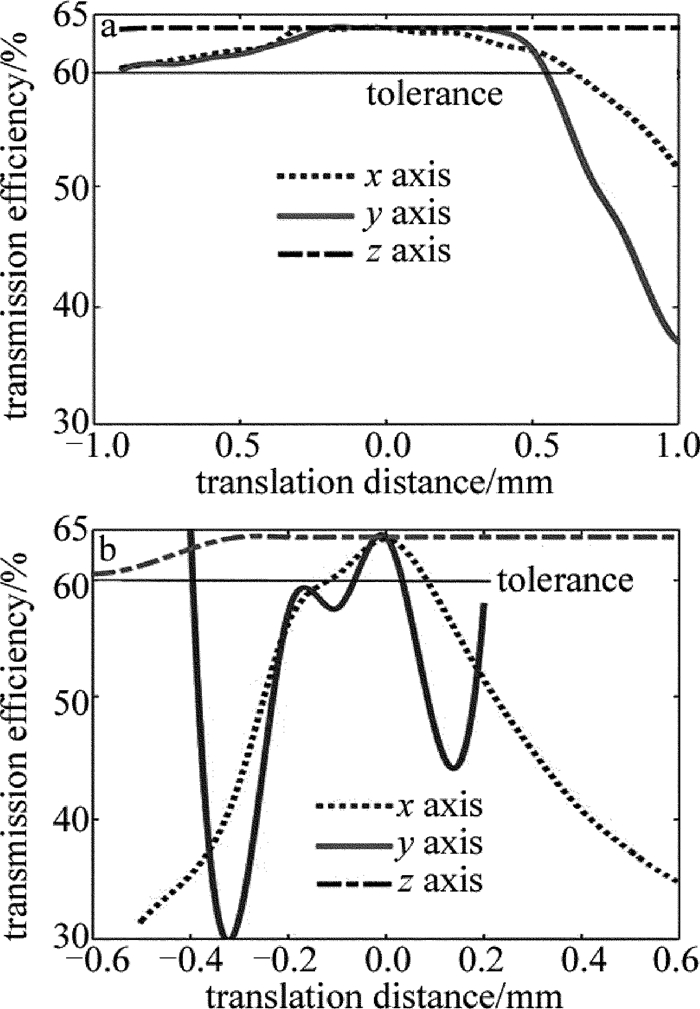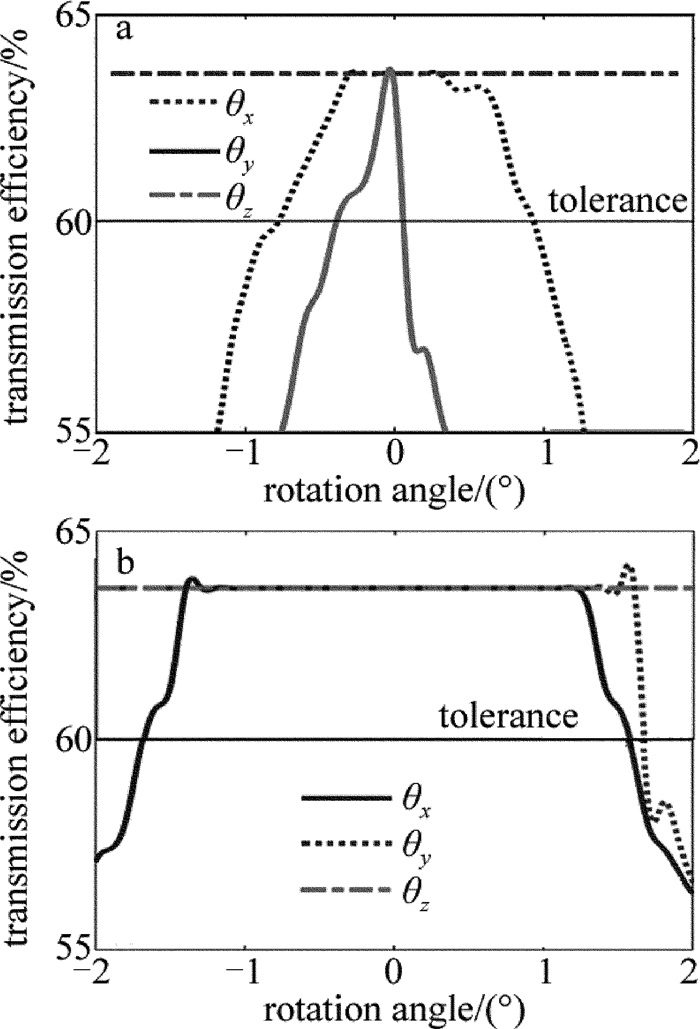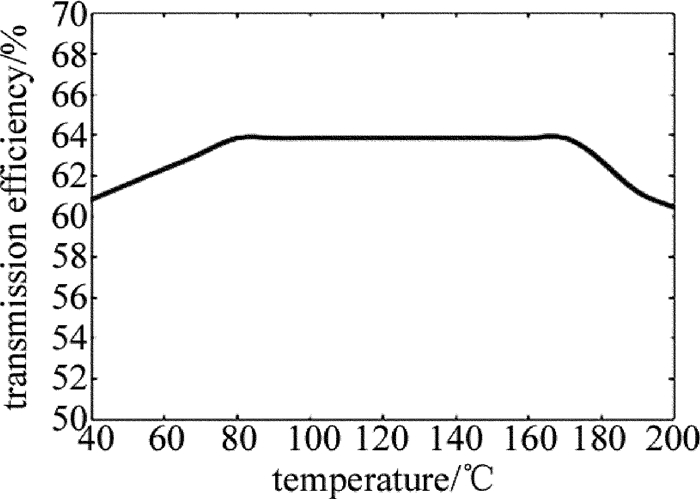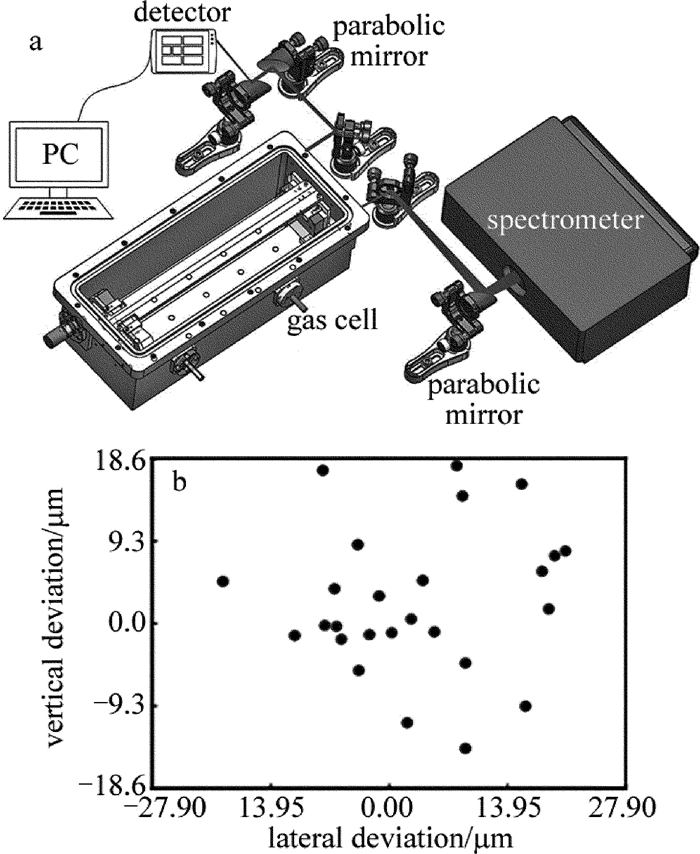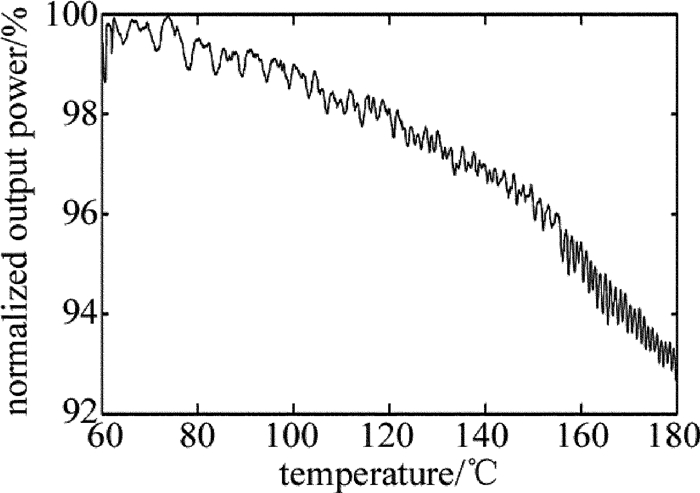Optimization design of transmission for on-line VOCs sensing gas cell
-
摘要: 为了满足环境监测需求,需要研制一种能够对挥发性有机化合物(VOCs)成分进行在线高灵敏度、高保真监测,并适用于傅里叶变换红外光谱探测配备的气体吸收池,采用光学追迹结合有限元分析的方法,分别对气体池物镜夹持调节机构与光学整体结构固定方式进行优化设计,较为有效地解决了在VOCs监测中气体池工作温度要求下光学器件形变校正的问题,可优化80℃~180℃工作范围内的光能传输效率。给出了一种适用于VOCs气体特定温度条件下吸收池出射能量优化设计的方法,并以此方法为基础,设计加工了一型气体吸收池,进行了热环境测试。结果表明,该吸收池具备在80℃~180℃工作范围内稳定的传输效率,能够应用到VOCs在线监测系统中进行测量。Abstract: In order to meet the needs of environmental monitoring, one gas absorption pool was developed. The gas pool could monitor the composition of volatile organic compounds (VOCs) on-line with high sensitivity and high fidelity, and was suitable for the equipment with Fourier transform infrared spectrum detection device. The method of combination of finite element analysis and optical trace was used to do optimization design of gas pool lens clamping adjustment and the fixed mode of optical whole structure. The problem of distortion correction of optical devices in VOCs monitoring of gas pool was solved effectively. The energy transmission efficiency can be optimized in the working range of 80℃ to 180℃. The method of optimization design of absorption pool output energy, suitable for VOCs gas and at specific temperature, was presented. Based on the method, one type of gas absorption pool was designed and the thermal environment test was carried out. The results show that, the absorption pool has stable transmission efficiency in the working range of 80℃~180℃ and can be applied in on-line VOCs sensing system.
-
引言
蛋类是生活中常见的食物,不论是蛋类还是蛋制品都具有非常高的营养价值,同时一些蛋制品也存在着食品安全问题,如皮蛋在由鸭蛋腌制而成的过程中可能会存在着重金属元素铅残留的问题。关于皮蛋中铅的残留是一直以来大家关注的问题,在此之前也有过这方面的研究[1-2],食用含铅皮蛋会危害人体安全,严重的会导致铅中毒。然而基于原位在线探测技术的蛋壳成分检测和蛋类快速甄别一体化研究尚鲜见文献报道。
激光诱导击穿光谱技术(laser-induced breakdown spectroscopy, LIBS)技术是一种方便快捷并且准确度高的光电检测手段,通过脉冲激光聚焦样品表面形成等离子体后对等离子体发射光谱进行分析,具有探测元素种类多、样品准备简单、响应速度快、探测准确度高等优点[3-5],已被应用于多方面的探测与研究,如食品学[6]、药学[7]、重金属污染[8-10]、采矿冶金[11-13]等方面。
反向传播神经网络(back propagation neural network, BPNN)算法是一种按误差反向传播训练的多层前馈网络,由输入层、隐藏层和输出层组成,计算时正向传输,由输入层至输出层,之后会对输出结果与期望值进行对比,若未达到期望效果,则会反向传播,将输出误差经过隐藏层向输入层逐层传输,并且会调整各层的权值以及各层之间的联接强度。不断重复这样的过程,直至输出结果达到期望效果则停止训练[14]。
本文中结合LIBS技术与BPNN方法对蛋壳进行元素探测,同时对不同种类的蛋壳进行快速甄别,探究不同种类以及不同制作方法的蛋壳的元素差异。采用LIBS技术对被污染的皮蛋壳中的铅元素进行探测,为蛋类的快速甄别以及污染蛋类的检测提供一个新的研究方法。
1. 实验方案与装置
本文中搭建了如图 1所示实验装置。选取市场采购的鸡蛋、鸭蛋、鹌鹑蛋和皮蛋经过清水清洗以及静置风干后作为实验样品。实验过程中,激光经由反射镜之后由透镜聚焦在样品表面,样品表面原子在高温下吸收能量发生能级跃迁,并在冷却后释放出相应的等离子体,光谱仪采集等离子体光谱后呈现在电脑端。实验装置已在一些参考文献中有详细介绍[15-16], 其中,激光器是以Nd ∶YAG为工作介质的,调Q时间为150μs,工作波长为1064nm,重复频率为10Hz,持续时间为6ns,激光单次脉冲的最高能量为680mJ,本实验中激光脉冲能量为100mJ;使用的平凸透镜焦距为150mm;光谱仪的波长范围为200nm~880nm,分辨率为0.1nm。
2. 结果与讨论
2.1 蛋壳元素快速检测
实验中采用LIBS技术对蛋壳进行快速的元素分析,所选取的样品是单个鸭蛋壳,对样品进行LIBS探测后所得的全通道谱线如图 2所示。谱线被分成200nm~320nm(见图 2a),320nm~470nm(见图 2b),480nm~680nm (见图 2c)和690nm~880nm(见图 2d)4个波段分析。将实验所得谱线数据与美国国家标准与技术研究院(National Institute of Standards and Technology,NIST)数据库中的数据相对应并且在误差范围内进行元素的标定。分析实验光谱并结合实际条件,发现鸭蛋壳中含有Si,Cu,Ca,Mg,Al,C,Na等元素。Cu是重金属元素,同时也是重要的营养元素,实验中检测到Cu元素的多个特征峰,包含了Cu的原子态和离子态(Cu Ⅰ 213.598nm,Cu Ⅰ 221.458nm,Cu Ⅱ 224.700nm和Cu Ⅰ 223.008nm等);还有金属元素Al(Al Ⅱ 308.215nm,Al Ⅱ 309.271nm,Al Ⅰ 394.401nm和Al Ⅰ 396.152nm等),金属元素Mg(Mg Ⅱ 279.553nm,Mg Ⅱ 279.800nm,Mg Ⅱ 280.271nm和Mg Ⅰ 285.213nm等)。
2.2 蛋类的快速甄别
图 3是鸡蛋壳、鸭蛋壳和鹌鹑蛋壳在200nm~320nm波段内的LIBS谱线。当前对于不同蛋类的区分是基于蛋壳的颜色不同,但当几种蛋壳的颜色较为相近时,根据颜色分析就会有一定的难度,本文中为了研究不同蛋类的甄别,选取了3种部分区域颜色相近的蛋壳(鸡蛋壳、鸭蛋壳和鹌鹑蛋壳)。实验中,3种蛋类各选取一个样品进行试验。将实验中得到的LIBS谱线图与NIST数据库相对应后进行元素的标定,通过实际情况结合光谱分析,3种蛋壳的谱线在200nm~320nm这一范围内存在较为明显的区别。在200nm~320nm内,3种蛋壳均被检测到Ca,Mg,C元素,其中鸡蛋壳含有最少的元素种类;鸭蛋壳被检测到的谱线峰最多,含有的元素种类最多,被检测到了除Ca,Mg,C元素外的Si,Al,Cu元素;鹌鹑蛋壳除Ca,Mg,C元素还被检测到P等元素。
在剩余波段的谱线中,3种蛋壳的LIBS谱线差异较小,均探测到Ca,C,Mg,N,O等元素,其中鸭蛋壳的谱线多出一些Cu元素的特征峰(510.554nm,521.820nm等),Si元素的特征峰(670.698nm等),鸡蛋壳以及鹌鹑蛋壳的谱线相似。
实验中采用LIBS技术与BPNN相结合的方法对不同蛋壳进行甄别工作的研究,在分类之前,所采集到的空气的LIBS谱线,对于本研究是无效数据,同时还有一些峰值达到饱和的谱线也是无效谱线,算法会以此为基础,在实验得到的所有谱线中选择出有效谱线进行后续的处理。鸡蛋壳、鸭蛋壳和鹌鹑蛋壳都选择200组的谱线数据,其中80%作为分类集,20%作为测试集。算法对谱线数据进行主成分分析(principal component analysis,PCA)、相关主成分(principal component, PC)的方差贡献率和累计贡献率如表 1所示。其中91.0247%的贡献率来自于前3个主成分,贡献率分别为42.2870%,34.7557%,8.9822%,说明这3个主成分大体包含了蛋壳样品的大部分信息,因此,分类时以这3个主成分进行分析。分类的结果如图 4所示,其中3维坐标分别为3个主成分的得分,圆形的数据点为鸡蛋壳,六角星的数据点为鸭蛋壳,五角星的数据点为鹌鹑蛋壳。根据分类结果,3种蛋壳可以明显地区分开,达到了预期的实验效果。
Table 1. Variance contribution rate of each principal component (eggshell, duck eggshell, and quail eggshell)PC variance contribution rate/% cumulative contribution rate/% PC 1 47.2870 47.2870 PC 2 34.7557 82.0426 PC 3 8.9822 91.0247 PC 4 3.3992 94.4240 PC 5 2.5373 96.9613 PC 6 1.5343 98.4957 PC 7 1.0149 99.5105 PC 8 0.3141 99.8246 PC 9 0.1370 99.9616 PC 10 0.0384 100 在得到了分类结果之后,算法会对分类结果进行检验,测试集是上面提到的200组数据中的20%的数据。经验证,此次分类工作的准确度为94.167%,与采用BPNN在其它领域中的工作相比较时准确度是比较高的:YANG等人将BPNN应用于生物识别领域,达到了92.77%的准确率[17];CHENG等人将BPNN应用于地理方面研究,达到了86.8%和80.2%的准确率[18]。对于之后的盲检,对样品经过上面描述的处理之后,根据得到的数据点位于图中的位置可以得出未知谱线对应的蛋壳种类,能够完成蛋类的快速甄别。
在对样品进行选取时,3种蛋类各选取了一个样品进行实验与研究,对于来自不同地区、不同饲养场的这3种蛋类而言,由于生产环境、饲料选取等方面存在差异,所以结果也会受到影响。实验中以选取的样品为例,就3种蛋壳的元素探究以及分类提供一个思路与方法,并且将该方法应用于不同场景下的蛋壳分类。
LIBS和BPNN有着非常好的适配性,BPNN算法可以直接处理LIBS采集到的光谱数据,由于BPNN已经完成了对应的训练,可以直接分析出谱线所对应的蛋壳种类,并且结合LIBS技术本身的优势,系统的响应速度快,检测结果迅速,两者结合的测试方法能够做到非常好的时效性和较高的准确率。LIBS技术与BPNN算法相结合的方法也可以应用于更多的场景,LIBS的测试样品要求低,测试种类齐全,并且BPNN的应用范围也很广泛,所以LIBS与BPNN相结合有着很好的研究前景。
2.3 蛋类不同制作方法的蛋壳的鉴别
前面对于不同种类的蛋壳进行了甄别,本节中将研究范围扩展到蛋类的不同制作方法的蛋壳的分类。选取鸭蛋壳和由鸭蛋腌制而得的皮蛋壳为实验样品。实验中,各选取一个鸭蛋壳和皮蛋壳作为样品,采用LIBS技术对两种蛋壳进行元素分析,将两种蛋壳的LIBS谱线进行比较后发现在200nm~320nm内存在一定的差异,该范围内谱线对比图如图 5所示。两种蛋壳的LIBS谱线整体较为相似,检测出的元素种类也大体相同,但Si元素的一些特征峰(如Si Ⅰ 250.690nm,Si Ⅰ 251.611nm,Si Ⅰ 252.411nm,Si Ⅰ 252.851nm和Si Ⅰ 263.128nm) 只在鸭蛋壳中被检测出来,皮蛋壳中却没有,对此,参考文献中鲜有报道,作者猜测是由于腌制过程中发生的化学反应对蛋壳中的元素产生了一定的影响。
采用前面介绍的BPNN算法,结合实验所得的鸭蛋壳和皮蛋壳的LIBS谱线来对两种蛋壳实现分类工作。同样由算法对谱线数据进行筛选后进行主成分分析,相关主成分的方差贡献率和累计贡献率如表 2所示。其中92.6120%的贡献率来自于前3个主成分,贡献率分别为56.6306%,27.6369%和8.3445%,这3个主成分大体包含了蛋壳样品的大部分信息,所以分类时以这3个主成分进行分析,所得结果如图 6所示。其中圆形数据点为皮蛋壳,六角星数据点为鸭蛋壳,3个坐标轴分别为3个主成分的得分,分类结果显示两种蛋壳之间有着明显的区别,并且经过验证之后,区分的准确率达到了97.5%,能够达到鉴别两种不同蛋壳的效果。
Table 2. Variance contribution rate of each principal component (duck eggshell and preserved eggshell)PC variance contribution rate/% cumulative contribution rate/% PC 1 56.6306 56.6306 PC 2 27.6369 84.2675 PC 3 8.3445 92.6120 PC 4 2.8380 95.4501 PC 5 1.5848 97.0348 PC 6 1.1811 98.2159 PC 7 0.8286 99.0446 PC 8 0.5592 99.6038 PC 9 0.3204 99.9242 PC 10 0.0758 100 本节中将实验对象进行了扩展,从不同种类的蛋壳拓展到同种蛋类不同产品的壳,选取的样品为采购的同一出处的鸭蛋和皮蛋,不同来源的样品对实验结果是存在一定的影响的,但是不同蛋制品的制作方法是较为固定的,实验以采购的样品为例,研究和建立LIBS技术和BPNN算法的结合方法,用于不同制作方法的蛋制品的壳的分类,为后续不同产地、不同来源、不同制作方法的蛋类元素探测、分类与甄别提供思路。
2.4 蛋类的铅污染研究
针对于蛋类的食品安全问题,本节中就蛋类的重金属元素污染问题展开研究。皮蛋由于制作工艺,在腌制的过程中可能会存在铅残留的问题,一旦食用了污染的皮蛋会造成人体铅中毒危害人的生命安全。因此为了探究蛋类重金属元素污染问题,本文中选取了皮蛋为研究对象,调配体积分数为0.01的醋酸铅溶液,将皮蛋放入调配好的溶液中完全浸泡10min后取出,纸巾擦拭干净后作为实验样品,用同样参量的激光进行LIBS探测。将得到的含铅皮蛋壳的LIBS谱线与未作处理的皮蛋壳LIBS谱线进行对照,图 7为部分波段的两者谱线对照图。其中图 7a中为皮蛋壳的谱线,图 7b中为含铅皮蛋壳的谱线。两种蛋壳的谱线大体相同,但在图中虚线所标示的波长处(217.000nm,282.319nm,283.305nm,287.331nm,363.956nm,368.346nm,405.780nm),只有含铅皮蛋壳的谱线有峰,将这些峰的波长一一与NIST谱线库中已经记录的铅元素的特征峰波长进行对比,证实这些波长均为铅元素特征峰的波长,说明可以采用LIBS技术对蛋类重金属污染元素的探测与研究。
实验模拟皮蛋的腌制中被重金属铅污染过程,配制不同体积分数的醋酸铅溶液。将蛋壳浸泡在溶液中5min后取出吹干进行检测,得到了如图 8所示的不同体积分数的溶液浸泡的皮蛋壳的谱线,图中展示了Pb Ⅰ 405.780nm和Cu Ⅰ 407.558nm两个特征峰的相对强度。溶液的体积分数降低时,铅元素特征峰的强度也随之降低,在溶液体积分数为5×10-6时,Pb Ⅰ 405.780nm的强度非常低,并且实验时将体积分数再降低后检测不到该特征峰,所以认为最低可以检测到体积分数为5×10-6的溶液中的铅元素。
3. 结论
本文中结合LIBS和BPNN开展了对于蛋壳元素的相关研究。通过LIBS探测以及元素标定发现了鸭蛋壳中含有Si,Cu,Ca,Mg,Al,Na等元素,其中检测到了明显的并且完整的Cu元素和Al元素的特征峰。同样对于鸡蛋壳和鹌鹑蛋壳的元素探测发现,在200nm~ 320nm内,3种蛋壳均发现Ca,Mg,C元素,同时,在鹌鹑蛋壳中还发现了P等元素、在鸭蛋壳中还发现Cu,Si等元素。借助BPNN对这3种蛋壳进行分类,得到了较为明显的区分图,并且经过检验得到了94.167%的分类准确度。采用同样的方法对鸭蛋壳和皮蛋壳进行分类,研究不同制作方法的蛋壳之间的元素区别,得到了97.5%的准确度。两种分类的结果以及检验结果的准确率都是很高的,说明LIBS与BPNN的结合可以很好地做到对于不同种类的蛋壳以及相同种类不同制作方法的蛋壳的分类。由于皮蛋的制作过程中存在铅元素的残留问题,食用含铅皮蛋会对人体安全造成影响并存在铅中毒的可能,实验中通过LIBS对污染的皮蛋壳进行探测,检测到了蛋壳中多条铅元素的特征峰并进行了标定,为蛋类的污染检测以及污染元素判定提供了新的方法。同时实验模拟皮蛋的腌制中被重金属铅污染过程,结果表明,最低可以检测到体积分数为5×10-6的溶液浸泡的皮蛋壳中的铅元素。
-
-
[1] QIANG W, GANG Z, QI Z. Status and needs research for on-line monitoring of VOCs emissions from stationary sources[J]. Environmental Science, 2013, 34(12):2-3. http://d.old.wanfangdata.com.cn/Periodical/hjkx201312040
[2] MEI J, LAN Z, QIAN L X. Definition and control indicators of volatile organic compounds in China[J].Environmental Science, 2015, 36(9):3522-3532. http://d.old.wanfangdata.com.cn/Periodical/hjkx201509051
[3] BERNSTEIN H J, HERZBERG G. Rotation-vibration spectra of diatomic and simple polyatomic molecules with long absorbing paths[J]. Journal of Chemical Physics, 1948, 16(1):30-39. DOI: 10.1063-1.1698927/
[4] XIN C K. Trace gas detection by miniature multi-pass differential optical absorption spectroscopy[D].Beijing: Tsinghua University, 2010: 36-45(in Chinese).
[5] WHITE J U. Very long optical paths in air[J].Journal of the Optical Society of America, 1976, 66(5):411-416. DOI: 10.1364/JOSA.66.000411
[6] HERRIOT D R, SCHULTE H J. Folded optical delay lines[J]. Applied Optics, 1965, 4(8):883-889. DOI: 10.1364/AO.4.000883
[7] RUI W. Research on the long-path cell of infrared spectrum instrument[D]. Tianjin: Tianjin University, 2006: 25-26(in Chinese).
[8] WEI Z. Studying of air quality monitoring system based on FTIR[D]. Tianjin: Tianjin University, 2006: 44-45(in Chinese).
[9] PENG A Y. Design of the optical structure of the mid-infrared gas sensing system by using the TracePro[J]. Laser & Infrared, 2009, 39(11):1198-1200(in Chinese). http://www.wanfangdata.com.cn/details/detail.do?_type=perio&id=jgyhw200911016
[10] HUANG D S. Design of micro-displacement mechanism and analyzing of accuracy in a long optical path air sumulan cell[J]. Journal of Changchun Institute of Optics and Fine Mechanics, 1993, 16(4):45-48(in Chinese). http://en.cnki.com.cn/Article_en/CJFDTotal-CGJM199304009.htm
[11] HUA H Z. Effect of nonuni form temperature distribution in gas cell on gas absorption transmissivity[J]. Transactions of Beijing Institute of Technology, 2011, 31(7):865-866(in Chinese). http://en.cnki.com.cn/Article_en/CJFDTotal-BJLG201107026.htm
[12] BARTLOME R, BAER M, SIGRIST M W. High-temperature multi-pass cell for infrared spectroscopy of heated gases and vapors[J]. Review of Scientific Instruments, 2006, 78(78):1-2. http://www.ncbi.nlm.nih.gov/pubmed/17503910
[13] HUA X, ZHONG D F, JIE G T. High sensitive detection of carbon monoxide based on novel multi-pass cell[J]. Acta Optica Sinica, 2010, 30(9):2597-2598(in Chinese). http://www.wanfangdata.com.cn/details/detail.do?_type=perio&id=QK201001877032
[14] MONDELAIN D, PEYRET C C, MANTZ A W, et al. Performance of a Herriott cell, designed for variable temperatures between 296 and 20K[J]. Journal of Molecular Spectroscopy, 2007, 24(1):18-25. http://www.wanfangdata.com.cn/details/detail.do?_type=perio&id=2b7170d96b085b974282ee05188c5cdf
[15] YAO X. The design of several special optical systems and finite element analysis[D]. Beijing: Beijing Institute of Technology, 2015: 24-26(in Chinese).
-
期刊类型引用(2)
1. 吴清潮,吴坚. 基于脉冲激光的发射药参数快速检测方法. 激光技术. 2024(02): 171-179 .  本站查看
本站查看
2. 林惠玲,洪儒哲. 基于虚拟仪器皮蛋无损分选系统设计. 现代信息科技. 2021(13): 1-4 .  百度学术
百度学术
其他类型引用(1)




 下载:
下载:







